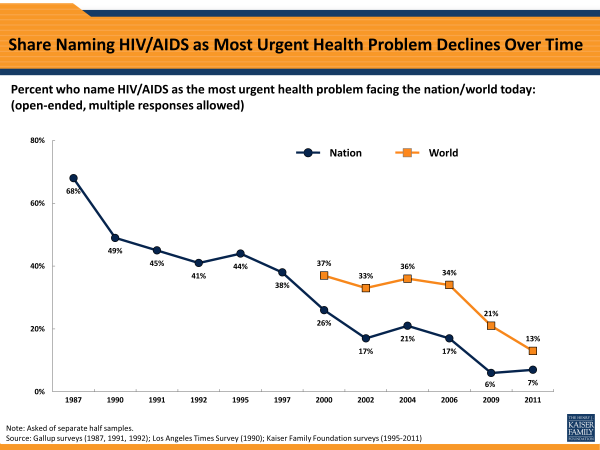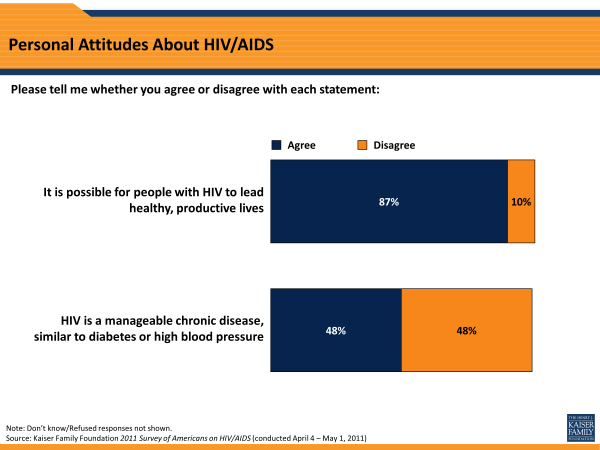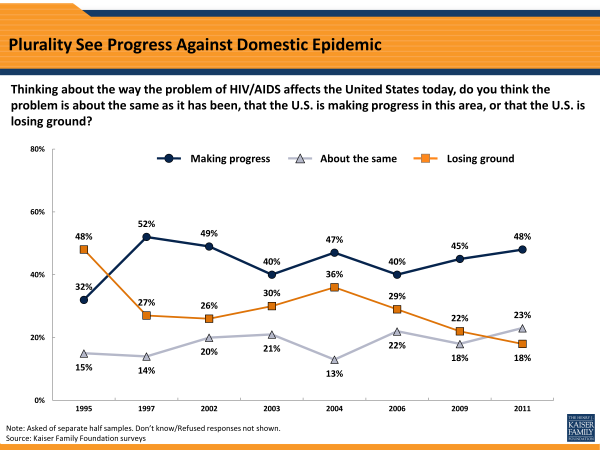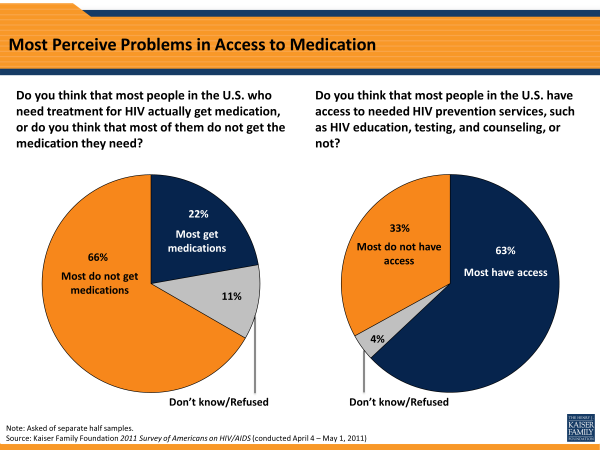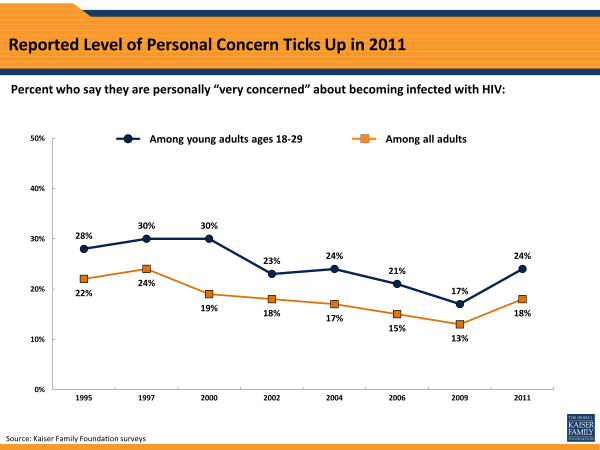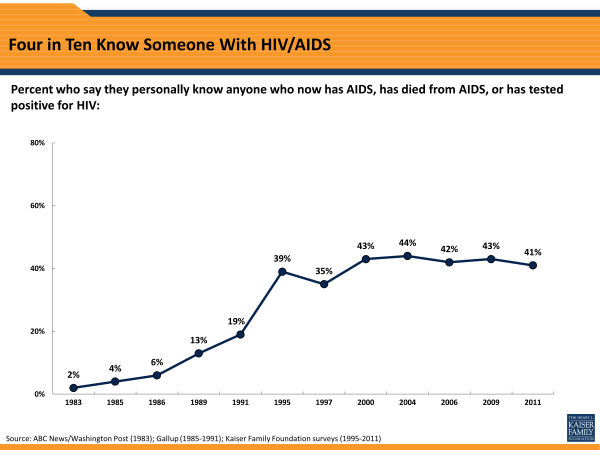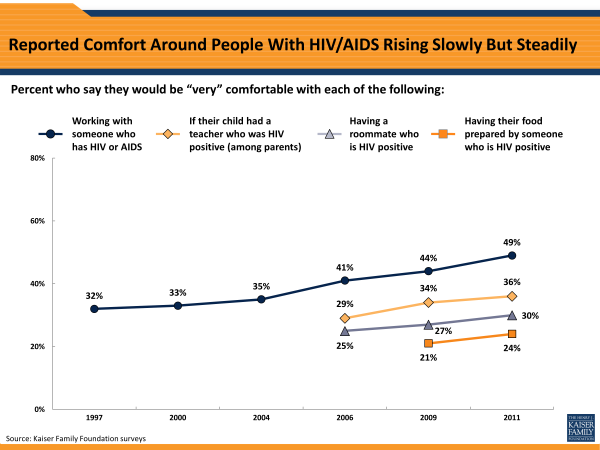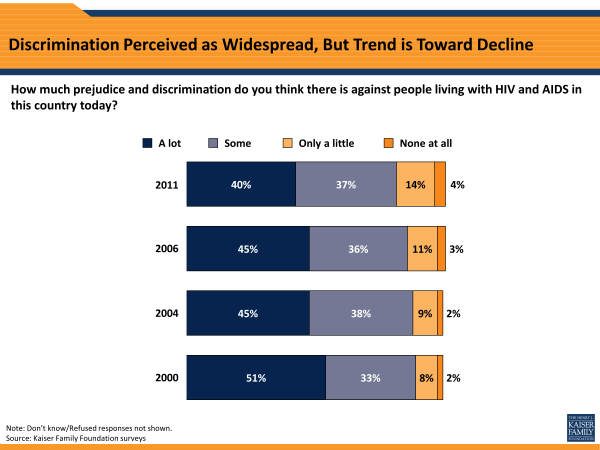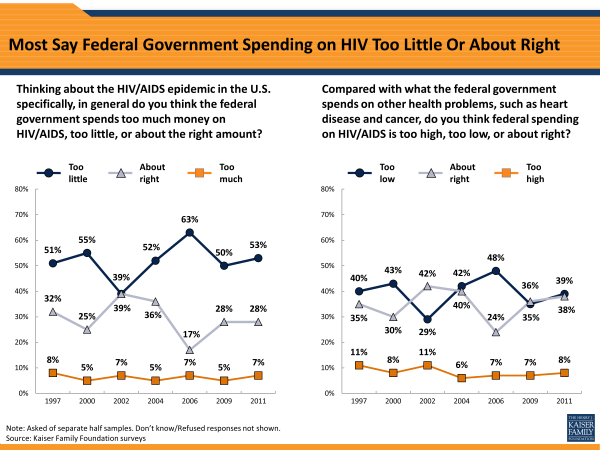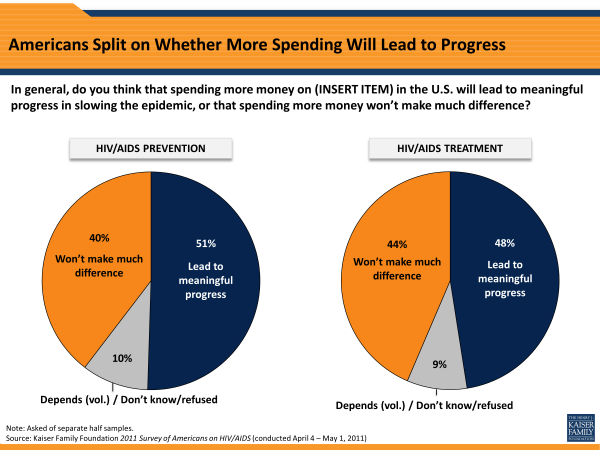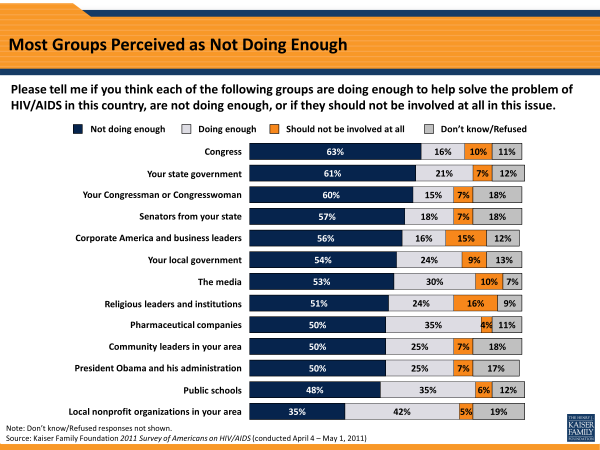HIV/AIDS at 30: A Public Opinion Perspective
Section 1: The Dynamics of American Opinion on HIV/AIDS
Americans have lived with AIDS in their midst for thirty years, since it was first recognized as an unexplained pattern of illnesses in 1981.1 They have experienced early waves of panic, witnessed the identification of HIV as the cause of AIDS, and celebrated the development of life-saving antiretroviral drugs. They have seen incidence peak in the 1980’s, decline, and then level out since the turn of the new millennium.2 As time has passed, they have seen the illness morph from one that was initially associated almost exclusively with gay white men, into something that has had an increasing impact on blacks, Latinos, and women. They have waited, so far in vain, for a cure, but have seen amazing progress in prevention and treatment. American public opinion has reacted to these developments and trends in different ways, with people’s views—and the intensity of interest—shifting as the disease became more familiar, as scientific advancements began to help people live longer and better lives after their diagnosis, and as HIV/AIDS began to affect different populations.
As Disease Becomes More Well Understood And Therapies Developed, Perceived Urgency Of Aids Diminished
In 1987, the Gallup Poll found that HIV/AIDS was seen by the large majority of Americans (68 percent) as the most urgent health problem facing the country. This was a year in which the World Health Organization first launched its Global Programme on AIDS, the AIDS Memorial Quilt was first displayed on the National Mall, and President Reagan made his first public speech about the disease.3 By the time the next survey was fielded in 1990, national AIDS policy had developed to the point that the U.S. Congress was passing the Ryan White Comprehensive AIDS Resources Emergency (CARE) Act, and the share of the public naming AIDS as a top problem had fallen to 49 percent. This measure further declined in the 1990’s, a decade that saw major advances in HIV treatment including the development of effective combination anti-retroviral therapy. By 2009, the proportion who named AIDS as the nation’s top health problem had fallen to single digits, where it remains in 2011. As will be discussed in more detail in the next section, black Americans (19 percent) are more likely than others to name HIV as the nation’s most urgent health problem. The share naming HIV/AIDS as the world’s most urgent health problem—which has consistently been higher than the share saying so about the nation—has also dropped over the past five years, from 34 percent in 2006, to 21 percent in 2009, to 13 percent now.
| Figure 2: What Do You Think Is The Most Urgent Health Problem Facing This Nation Today? (open-ended, multiple responses accepted) | |
| Percent who say: | |
| Cancer | 25% |
| Obesity | 20 |
| The uninsured | 15 |
| Heart disease | 12 |
| Health care costs | 11 |
| Diabetes | 9 |
| HIV/AIDS | 7 |
| Health care access | 4 |
Topping the national list now are issues like cancer—a disease encompassing an enormous variety of illnesses, many terminal—obesity, and the problem of the uninsured.
In the era of anti-retroviral therapies, the public also seems unsure how to view the disease. While almost all Americans now believe it is possible for people with HIV to lead healthy, productive lives, the public is split on whether HIV should be perceived as a manageable chronic disease, similar to diabetes or high blood pressure—48 percent agree that it should and 48 percent disagree.
| Figure 3: Percent Who Say They Have Seen, Heard, Or Read “A Lot” Or “Some” About HIV/AIDS In The U.S. In The Past Year | |||
| A lot | Some | A lot/Some (Net) | |
| 2011 | 13% | 27% | 40% |
| 2009 | 14 | 31 | 45 |
| 2004 | 34 | 36 | 70 |
In recent years, Americans’ reports of hearing about the issue of HIV/AIDS—either through the media or in conversation—have also diminished. In 2004, 70 percent of Americans reported having seen, heard or read at least something about the domestic AIDS epidemic over the course of the past year. Five years later, in 2009, that proportion had dropped to less than half (45 percent), and it declined somewhat further to 40 percent in 2011. The survey suggests that the global HIV/AIDS epidemic has also lost some visibility over time, dropping from 71 percent who had seen at least something about the problem of AIDS in Africa in 2004, the year that President George W. Bush’s PEPFAR program (President’s Emergency Plan for AIDS Relief) was initially funded, to 55 percent in 2009 to 49 percent now. To some extent, as we will see in the next section, this may be due to the fact that the American public is more likely than not to see the epidemic as increasingly under control.
Plurality Consistently Say Country Making Progress in Fight Against HIV/AIDS
While there is no majority consensus as to whether the United States is making progress in the battle against HIV/AIDS at home, since the late 1990’s somewhere between roughly 40 to 50 percent of Americans have consistently said they think the nation is gaining ground. At the same time, the proportion who see the nation as losing ground has declined steadily in recent years, from 36 percent in 2004, down to 18 percent in 2011. Another 23 percent now see the situation as in a steady state. This trend towards an increased sense of progress seems to parallel the decreased sense of urgency mentioned above. There has also been a similar downward trend in the share who think the world is losing ground in fighting the global HIV/AIDS epidemic (26 percent, down 23 percentage points since 2004); half (51 percent) now think the world is making progress on the disease.
Despite these perceptions of progress, many Americans recognize that challenges remain in certain areas, even when it comes to the domestic epidemic. While a majority (63 percent) believe that most U.S. residents have access to needed HIV prevention services, about two-thirds (66 percent) say that most people in the U.S. who need treatment for HIV do not get the medication they need. Treatment access is in fact an issue. It is estimated that roughly 60 percent of people with HIV in the U.S. are not receiving regular care for the disease.4 Access to treatment is not only important for those with HIV/AIDS, but also has recently been found to be a crucial part of reducing the risk of transmission to others.5
After Decade of Slow Decline, Concern About Infection Ticks Back Up
For the first time since 1997, and after more than a decade of slow but steady decline, the share who report being “very concerned” about becoming infected with HIV is up this year. That proportion rose from 13 percent in 2009 to 18 percent this year, an increase driven largely by young adults, among whom personal concern increased from 17 percent to 24 percent.
In 1995, just over half of parents reported being “very concerned” about a child becoming infected, but over the course of the next decade this concern lessened considerably to about a third of parents, a proportion which has stayed steady for the past seven years. Black Americans have consistently expressed higher levels of concern about HIV infection, both for themselves, and for their children (see next section for more details).
Public Learning Curve on Transmission Has Flattened Out; But Slightly Increased Awareness of Ability to Prevent Mother-to-Child Transmission
While surveys showed the public learning curve dropping steeply over the first decade of the epidemic, since the start of the 1990’s the remaining myths about modes of transmission remain stubbornly persistent. Over the past twenty years, roughly one in four Americans have continued to either believe that one can get HIV from sharing a drinking glass, or remain unsure whether this is the case. Similarly, roughly one in six believe the same about HIV transmission via shared toilet seats, and 12 percent either think you can get HIV by swimming in a pool with someone with HIV, or are not sure whether this is the case. Overall, in 2011, one in three gave an incorrect answer to at least one of these three questions about means of transmission.
| Figure 9: Percent Saying The Following Statement Is True/False: “A Pregnant Woman Who Has HIV Can Take Certain Drugs To Reduce The Risk Of Her Baby Being Born Infected” | |||
| True | False | Don’t know | |
| 2011 | 53% | 26% | 21% |
| 2009 | 45 | 27 | 28 |
| 2006 | 44 | 26 | 29 |
| 2004 | 43 | 28 | 29 |
| 2000 | 43 | 28 | 29 |
| 1997 | 49 | 20 | 31 |
| 1995 | 30 | 36 | 34 |
Other types of misinformation persist as well. For example, a quarter of Americans are unaware that there is no vaccine available to prevent HIV infection, and about two in ten do not know that there is no cure for AIDS. Still, 2011 did mark an improvement in the percentage of Americans who recognize that there are medications available to reduce the chances that an HIV-positive woman will pass the virus on to her baby. Currently, 53 percent recognize this is the case, a number that rises to 57 percent among women in general and 76 percent among black women under age 30.
Potentially Stigmatizing Attitudes Persist, But Trend is Toward a Decline; Most Still Perceive Discrimination
HIV/AIDS cuts a wide swath in our population. Overall, since the start of the new millennium, roughly four in ten Americans have reported knowing someone with HIV/AIDS, and this proportion rises to nearly six in ten (57 percent) among blacks. Still, many Americans continue to report discomfort at the idea of interacting with those who are HIV-positive. Overall, 45 percent of Americans report being uncomfortable with the idea of having their food prepared by someone who is HIV-positive, 36 percent with the idea of having an HIV-positive roommate, 29 percent with having their child in a classroom with an HIV-positive teacher,6 and 18 percent working with someone who has HIV/AIDS. The survey data suggest there is a generational gap in reported comfort levels, with those ages 65 and older considerably more likely to say they would be uncomfortable living as a roommate with (56 percent), working with (33 percent), or having their food prepared by (62 percent) someone who is HIV-positive.
The survey suggests that such discomfort is in part linked to mistaken concerns about how HIV is transmitted. For example, those who correctly answered the three items about transmission laid out above are twice as likely as others to say they would be comfortable having a meal prepared by someone with the virus (62 percent say they would be comfortable, compared to 31 percent of those who did not get all three items correct.) The data also show that those Americans who personally know someone with HIV/AIDS express more comfort about interacting with people in all the above circumstances.
Despite these pockets of discomfort, the trend over the past decade and a half has been towards increasing comfort levels around people with HIV/AIDS. Currently, about half of Americans say they would be “very comfortable” working with someone who has HIV or AIDS, up from a third in 1997. While survey trends do not go back as far, there have been similar increases over the past five years in the proportion saying they would be very comfortable with having an HIV-positive roommate or an HIV-positive teacher in their child’s classroom.
| Figure 12: Percent Who Agree/Disagree With The Following Statements: | |||
| “In general, it’s people’s own fault if they get AIDS” | |||
| Agree | Disagree | Don’t know | |
| 2011 | 29% | 67% | 4% |
| 2002 | 40 | 55 | 4 |
| 19977 | 40 | 57 | 3 |
| 1991 | 33 | 63 | 4 |
| 1987 | 51 | 44 | 5 |
| “I sometimes think that AIDS is a punishment for the decline in moral standards” | |||
| Agree | Disagree | Don’t know | |
| 2011 | 16% | 81% | 2% |
| 2002 | 26 | 70 | 4 |
| 1997 | 31 | 66 | 3 |
| 1991 | 34 | 62 | 4 |
| 1987 | 43 | 50 | 7 |
A more dramatic example of both the remaining negative beliefs and the extent to which these are slowly (many would say too slowly) eroding, is the change in the share of Americans who agree with two strongly negative statements about AIDS. Currently, three in ten Americans (29 percent) say they agree that “it’s people’s own fault if they get AIDS,” a share that stood at 40 percent in 2002 and 51 percent when Gallup asked the question in 1987. Similarly, 16 percent of Americans say they “sometimes think that AIDS is a punishment for the decline in moral standards”, also down 10 percentage points since 2002 and dramatically lower than the 43 percent who said so in 1987.
In terms of ideas about personal culpability, men are somewhat more likely than women to buy into the concept that “it’s people’s own fault if they get AIDS.” Overall, 34 percent of men say they agree with this statement, compared with 24 percent of women.
In general, Americans perceive a good deal of discrimination against those living with HIV—40 percent say there is “a lot” of discrimination and another 37 percent say there is “some.” Over time, though, there has also been a slight decline in this measure, with the share perceiving “a lot” of discrimination down 11 percentage points since 2000.
Given the extent to which the HIV/AIDS epidemic has been associated with the gay community, the survey also sought to measure general attitudes towards and experiences with people who identify as gay or lesbian. Overall, about half (52 percent) of Americans say they have a family member or close friend who is gay or lesbian. While a plurality (47 percent) of Americans express the view that homosexuality is not a moral issue, a third say they personally believe homosexual behavior is morally wrong, compared with 12 percent who view it as morally acceptable.
Most Say U.S. Spending Too Little or Right Amount on Domestic HIV/AIDS Epidemic, Few Want to Decrease Funding
Over the past ten years—as federal funding for HIV/AIDS has been on the rise8 — Kaiser surveys have asked the public to weigh in on these funding levels both in isolation and in the context of spending on other pressing health problems such as cancer. The commonality across the two sets of results over time is that few Americans—never more than about one in ten—think the government should decrease spending on the domestic HIV/AIDS epidemic. This year, despite the continuing economic crisis, 53 percent say we are spending too little in fighting the epidemic at home, while 28 percent say we are spending the right amount. When asked in context of other illnesses, Americans are more divided: 39 percent say spending is too low, and 38 percent say it is about right.
About half of Americans also continue to believe that increased spending on both HIV/AIDS prevention and treatment will lead to meaningful progress in slowing the epidemic (51 percent say so for prevention, 48 percent for treatment). However, at least four in ten think such spending will not make much difference. And when it comes to spending on HIV prevention, skepticism appears to be on the rise—currently, 40 percent say such spending won’t make much difference, up from 31 percent in 2009.
Looking for a Leader
The public is hard pressed to name an individual who stands out as a national leader in the fight against HIV/AIDS. Three-quarters of Americans couldn’t name anyone as a national leader. No person who was mentioned made it into double digits. Overall, 8 percent named Magic Johnson, 5 percent named the recently deceased Elizabeth Taylor (whose death was heavily covered by the media just before the survey was in the field9, 2 percent named President Barack Obama, and 1 percent each named Elton John, Bill Clinton, George W. Bush and rock singer/activist Bono.
When asked about the efforts of a variety of individuals and institutions, the public says most of them are not doing enough to help solve the problem of HIV/AIDS in this country. Specifically, majorities would like to see more action on HIV from Congress (63 percent), their state governments (61 percent), their own Congressional representatives (60 percent) and Senators (57 percent), corporate America and business leaders (56 percent), their local governments (54 percent), and the media (53 percent). About half say the same about religious leaders (51 percent) and community leaders (50 percent), President Obama and his administration (50 percent), pharmaceutical companies (50 percent), and public schools (48 percent). The only group that a plurality (42 percent) believes is doing enough on HIV is local non-profits; still, a third (35 percent) think these organizations could be doing more.

